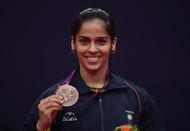A picture tells a thousand words. So did Mary Kom’s, after losing her semi-final bout to GB’s Nicola Adams. She was evidently disappointed with the result, as she had trained arduously and sacrificed willingly in the pursuit of winning a medal at London 2012 – not Bronze, not Sliver, only Gold. But at the same time, she was gracious in defeat, acknowledging the crowd for their round of applause, her opponent for a competitive bout and her coaches for their support. So down-to-earth, so humble – you would not guess Mary Kom is a five-time world and four-time Asian champion.
To this, Mary Kom has now added an Olympic medal, a Bronze, which in every Indian’s eye should glitter as Gold. It is not the numerous medals, the several world titles or the different awards she has received that make her a champion. She is a champion because of the long and painstaking path she has taken to get here, one that is very well documented. She is a champion because she has not just highlighted the sport of women boxing in India, but has embodied London 2012’s motto: Inspire a Generation. Mary is a role model for the next generation of aspiring female athletes in India, not just because she has given them hopes of winning an Olympic medal in the future. She is a role model because she has given hope to every girl child to take up sport, any sport of their choice and has taught women not to let marriage, children or their family give up on their sporting aspirations.
Mary and Saina are both champions in their own right, and now have an Olympic medal each to their names. India has a lot to learn from their success at London 2012, where till now the four medals that have been won by India are equally shared between women and men. This is in stark contrast to the fact that India sent 58 male athletes as compared to only 23 female athletes, to compete at London 2012. One wonders whether we would have won two more medals had we sent the same number of female athletes, given their conversion rate. Now people might question my logic by saying that to reach the Olympics, athletes have to qualify, and so the greater number of men in Team India is justified, and they are competing in London 2012 on merit.
This is true, but one has to dig deeper to see the reality. Women’s sport in India is very much neglected, right from the grassroots all the way to the elite level. There is a glaring disparity between male and female sport in India, in every aspect from access to proper equipment and infrastructure to provision of quality coaching. A simple example is this – why do men’s teams in different sports get coaching assistance from foreign professionals whereas women’s teams don’t? It’s true for many sports, be it cricket or football. The system in place does not allow as many girls to participate in sport as compared to boys, it does not allow as many aspiring female Olympians to make a mark in their sport, as compared to males.
Sadly, the reality of women’s sport in India is a reflection of the male chauvinism present within Indian society. I sincerely hope that Mary and Saina’s medals at London 2012 are a lesson to everyone that has an interest, a stake, as small as it may be, in Indian sport. We cannot let the effort and sacrifices of two true champions in Mary and Saina go in vain. London 2012 beckons a new era for female sport in India, to empower the female athlete.
By Suheil Tandon(The author is Co-founder & Partner, Pro4Sport Solutions, a high-performance coaching firm that trains young athletes in the sport of Basketball, Cricket, Football and Table Tennis)

